For over four decades, Benthem Crouwel Architects, led by partners Pascal Cornips, Daniel Jongtien, Saartje van der Made, and Joost Vos, has been at the forefront of architectural innovation, where each project is a reflection of their continuous pursuit of excellence and improvement. With a commitment to pragmatic idealism, they craft buildings that go beyond aesthetics, making meaningful contributions to urban ecosystems. Their collaborative approach, daring craftsmanship, and user-centric design have set them apart, creating structures that not only stand as testaments to architectural excellence but also seamlessly integrate into the fabric of the cities they inhabit.
Join us on a journey with Saartje van der Made and Joost Vos as they unravel the stories behind the award-winning architectural wonders, offering a glimpse into their innovative vision and the future of sustainable design.
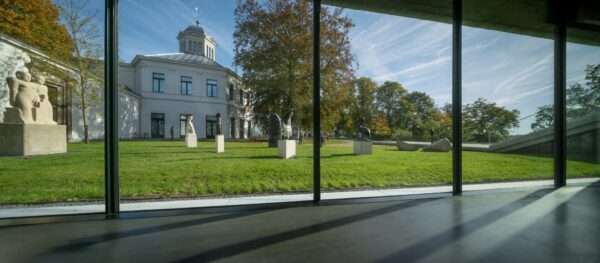
Photo Credit: Jannes Linders
At the heart of Benthem Crouwel Architects’ portfolio is the transformative renovation and expansion of the Museum Arnhem, a project led by Saartje van der Made and Joost Vos. Recognized with the prestigious BLT Built Design Award in Architectural Design – Cultural, the museum’s renewal is an exquisite dance between the old and the new. The unique floating wing, delicately balancing 15 meters over the moraine, is a testament to the audacious vision of the architects. The façade, adorned with 82,000 hand-crafted tiles, not only stands out but also seamlessly integrates with the natural surroundings, creating a harmonious dialogue between the structure and its environment.
We recently had the privilege of speaking with Saartje van der Made, who played a pivotal role in leading the design for the restoration of the Museum Arnhem. Her insights provide a glimpse into the process that resulted in a visible, well-organized museum.
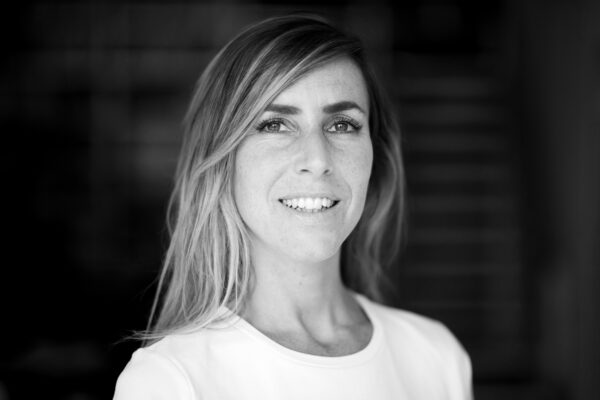
Saartje van der Made. Photo Credit: Anneke Hymmen
Your team has given new life to the Museum Arnhem by extending its space and renovating the old building: the result is a light space where art can truly be experienced. How did you integrate modern architectural design with the museum’s historic features?
Museum Arnhem asked for a design that addressed all their requests: a renovation, an expansion and better museum halls, all the while respecting the original building. We explicitly sought a contrast between old and new, expressing it through form, material and color. We wanted to add something truly contemporary, a new layer of time that represents the current zeitgeist. We took down the later extension that had been added to the historical dome, a former gentlemen’s club, to restore the original symmetry of the old building. Subsequently, we added a rectangular, simple volume with minimal detailing in opposition to the many details of the old building, such as the cast iron columns. By combining the existing historical structure with the newly designed volume, an exciting contrast emerges. In the converging areas between the old and new building, we emphasized this tension by making a subtle glass connection which makes it more pronounced. You consciously step from the old building into the new one, while the logical museum route seamlessly continues unnoticed, and the visitor is not distracted by the architecture navigating through the museum.
The Museum’s design incorporates 82,000 unique, hand-crafted tiles covering the facade and a monumental staircase inviting visitors in. Can you discuss the inspiration behind these design choices and how they reflect the museum’s connection with nature and art?
The wide staircase is the highlight of the route separate from the museum’s main pathway within the building. This is a route for which no admission ticket is required. In this way, we have emphasized the museum’s key value, accessibility – bringing art to everyone through our design. We have reopened the sculpture garden and the historical dome to the public. We allowed the separate flows of museum visitors and people exploring the public garden to intersect by incorporating a staircase that leads to a balcony cutting across the museum. On the balcony, you enjoy a spectacular view of nature while also getting a preview of what is happening inside, enticing you to purchase a ticket. The staircase is designed as a grandstand, providing an additional function as a stage and seating for outdoor performances.
For the façade, we looked for materials that would emphasize the sleekness of the new volume. The 82,000 handmade tiles give the building an extra layer, depth, and richness. From a distance, the perspective differs from what you observe up close. Approaching the museum, you see a sleek volume transitioning in color – from earthy tones on the streetside to icy blue on the side facing the river – symbolizing the museum’s location on the moraine created by a glacier. Up close, you notice that each tile is unique, a work of art in itself, aligning with the building’s function as a museum. The glazing imparts a distinct color to each tile, creating a unique reflection in daylight, sun, and shadow. This, together with the age-old craft of the baking process, adds an extra layer to the contrast of old and new.
By connecting the different exhibition and public spaces within the museum, you’ve not only enhanced the structure of the building but also the experience of the visitors. How did you approach the design process?
We wanted to open up the garden and add space, so we decided to bring all program requirements to one side. All spaces were connected into a single museum route that flows intuitively, guiding you through the museum. The greatest value of the location is the surrounding nature, the view of the beautiful landscape and the river below. Therefore, we chose to place the new volume on top of the moraine rather than below it. by doing this, we did not have to disrupt the ancient moraine, and we could keep one single level, making it highly accessible. We then added large windows, allowing visitors to have alternating moments of connection with art and nature.
With the addition of the spectacular overhang, making the building appear to float above the trees, we succeeded in giving the museum a contemporary new face, placing it back into the heart of society.
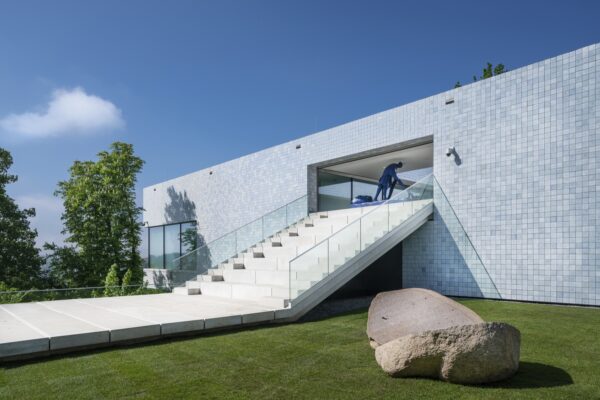
Photo Credit: Jannes Linders
Read more about the project HERE.
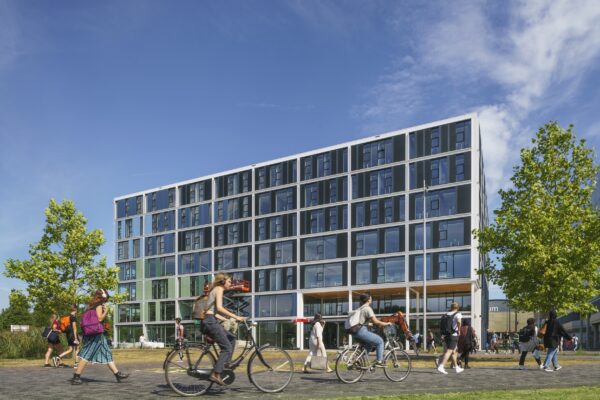
Photo Credit: Jannes Linders
Designed by Joost Vos, LAB42 at the Amsterdam Science Park earned accolades in Architectural Design – Educational at the BLT Built Design Awards. This 14,000 m2 structure stands as a symbol of innovation, featuring a modular design that allows for adaptability, reusability, and expansion. The 100% recyclable steel main frame, coupled with incorporated solar panels and rainwater reservoirs, makes LAB42 a pinnacle of energy-neutral, circular architecture.
In an exclusive interview, Vos shares insights into the challenges and choices that make LAB42 a groundbreaking structure.
LAB42 boasts a unique modular and sustainable design. Can you tell us about the challenges your team faced, and the innovations involved in creating such a structure?
The challenge was to ensure that the modular system we devised was consistently implemented. We aimed to minimize exceptions within the structural system. This began with choosing the right grid size, determining the dimensions of the grid that could accommodate the entire program with all its components. It was a quest to find the best grid. Ultimately, we decided on 720 by 720 in plan. Subsequently, the system was implemented as rigidly as possible, including the atrium where long columns and beams are visible. Even if there isn’t always a floor installed, we created the option that floor panels could be inserted in the future. The primary challenge was the selection of the right structure and then the choice of materials used, ensuring it was entirely demountable. All connections had to be detachable and reusable. The goal was to make the building adaptable to changing circumstances over the next 50 years and beyond, immediately after construction was complete. After its eventual lifespan, the building can be disassembled, reconstructed elsewhere, or repurposed.
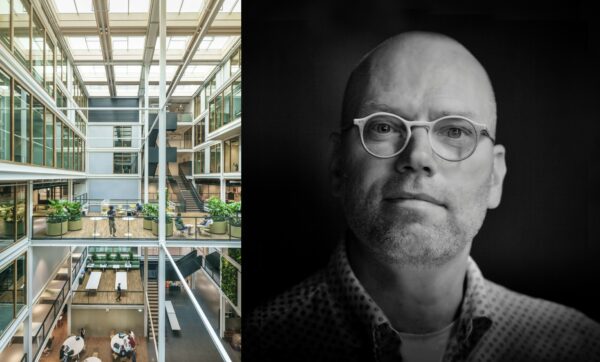
LAB 42. Photo Credit: Jannes Linders // Joost Vos. Photo Credit: Maarten van Schaik
You have used 100% recyclable materials in the construction, plus added solar panels and rainwater reservoirs. Making this the future of buildings – or so we hope. How did you decide to add these features and materials to the project? Was this choice influenced by the design vision and aesthetics or was it the other way around?
The modular concept has largely determined the aesthetics; the idea of making the grid and materials visible. We wanted it to be a comprehensible, clear building. It started with intrinsic sustainability. It’s not so much about putting solar panels on the roof and reusing rainwater, as that is a given. Intrinsic sustainability is about creating a building that is adaptable throughout its lifecycle without the need for demolition or the destruction of materials. LAB42 is currently an educational facility, but it could also become an office building, a laboratory or even a residential building — everything should be accommodated within that lifecycle. That is the foundation of sustainability. Then you construct the building with responsible materials, so that results in choices like steel, wood, or concrete, preferably second-hand as well. Even second-hand structural materials can be adopted in this building such as concrete slabs and hollow core floors. We experimented with this in LAB42. In the near future we will take larger steps in this to be even more sustainable.”
LAB42 creates a dynamic environment where several labs are visible. Bridges connect work landscapes, and transparent plinths lighten the atrium. How does this openness contribute to the functionality of the space?
LAB42 is a building in which collaboration takes place, a building for students and scientists who need to conduct their research in peace, but it is also important that they can come together to share their knowledge and research. As an architect, you try to create a building that easily facilitates this co-creation. So, we designed an open building, for example, with complete floors instead of bridges in the atrium, where people can meet and share their research. It allows you to see what others are working on. On the ground floor for instance, there is a robotics lab, adjacent to the atrium, with glass walls so that you can literally see the current situation in that field. This openness certainly contributes to the functionality of the building. We have succeeded in creating an educational building as a space for co-creation. Everywhere you look, you see people talking or working, alone or in larger groups. We also designed it so that there is a beautiful public route via the stairs to explore the building. With each floor up, you find something different. Thus, the building facilitates such a journey of discovery, encouraging the user to be curious and open to meeting up and collaborating.
What is unique about Lab42?
It’s the first time that such an adaptable building has been realized on such a large scale. Consideration has been given to all aspects of sustainable construction, not just as an energy-neutral building, which it is, but also through responsible use of materials and resources, ultimately making it intrinsically sustainable. I believe this comprehensive approach hasn’t been applied on this scale in the Netherlands before.
The Netherlands is certainly at the forefront of such an integrated sustainability approach, and I dare say this building is particularly leading. Many sustainable buildings are being created, but the sustainability issue often focuses on one aspect, such as a wooden construction, or being an energy-neutral building. LAB42 encompasses everything — responsible handling of content, energy, and adaptability for the future. So, all these aspects are taken into account, making it a truly unique and pioneering building.
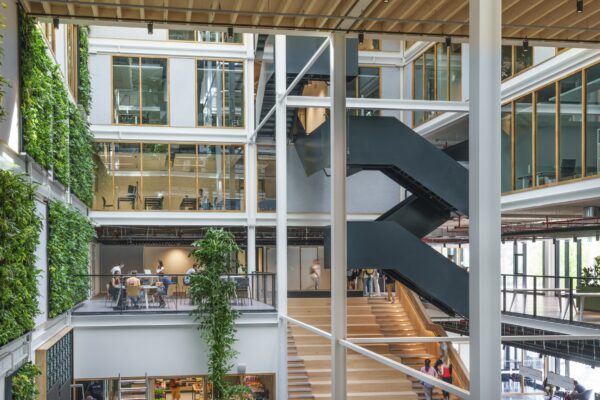
Photo Credit: Jannes Linders
Explore the 2023 winning projects in Architectural Design, Interior Design, Landscape Architecture, and Construction Product Design; along with captivating interviews, elegantly presented within our catalog. Each page is filled with stunning photos showcasing the winning designs.
You can purchase a print copy on Amazon and access freely the digital version on the BLT Awards website.
Dive into the forefront of design with our comprehensive catalog. It provides insights into the latest trends and techniques shaping the industry today. By getting your copy, you’ll access a wealth of knowledge and inspiration from top-notch professionals, helping you elevate your projects. Whether you’re a design pro or just love great aesthetics, our catalog has something to spark your creativity and keep you informed.
Meet Tam Leo, a Hong Kong-based interior designer with a passion for minimalist design styles and adept use of color. As the founder of DUMB Design, he has established himself as a prominent figure in the field. Leo recently received an Honorable Mention in Interior Design/Residential at the BLT Built Design Awards for his project, “Family Heirloom.” This residential unit, currently in its third generation, is situated in the heart of Hong Kong, offering a prime location and unobstructed views.
The “Family Heirloom” apartment presented a unique challenge and the renovation introduced an open-plan kitchen connected to the living room, allowing residents to enjoy breathtaking views of Hong Kong’s cruise terminal and the Central District – the city’s primary financial center – through strategically placed glass elements. Continue reading for Tam Leo’s insights into the details of the award-winning project and more about his innovative design approach.
Can you tell us about your background and personal journey through the design scene? How did design come to have such an important spot in your life?
I am from Hong Kong and have been working in the field of interior design for the past 7 years. I do not have any formal education or qualifications in interior design, but due to my interest in residential interior design, I began actively seeking information and studying the aesthetics of interior design about 7 years ago. I also learned computer-aided design software online, which marked the beginning of my journey in interior design.
In my opinion, everything in life is a form of art because each object goes through a design phase before it becomes a part of our daily lives. Besides dedicating my thoughts and creativity to interior design projects or work daily, I also design and plan my own life to make it more fulfilling and enriching.
What was the client’s vision for the “Family Heirloom” apartment and how did you apply it to the design?
This project is named “Heirloom” because it is the third generation of the family residing in this residence, and the homeowner wants to continue its legacy through redesign and renovation. Hence, I named it “Heirloom.”
The homeowner, who lives alone, finds the original layout with three rooms not very practical. She wishes to transform the unit into an open design concept while preserving the expansive view of the unit. The view from this unit overlooks Hong Kong’s Victoria Harbour, including the cruise terminal and ships sailing on the sea, as well as the Central Financial District on the opposite shore. Therefore, the homeowner desires a comfortable and minimalist design to create a focus on simplicity, allowing for a more comfortable and relaxed retirement lifestyle.
The apartment rests in the perfect Hong Kong location and boasts unobstructed views. How did these characteristics influence the design?
This residential design provides a stunning view of Victoria Harbour in Hong Kong, making it a truly exceptional location. The view offers a remarkable sight, including the opportunity to witness fireworks displays during various festivals.
In the design, I have made efforts to maximize the visibility of the view. For example, I removed existing walls and replaced the partition between the living room and the guest bathroom with glass. This allows for a seamless connection between the indoor spaces, enabling occupants to enjoy the beautiful scenery both when entering the interior space, while in the living room, or even when using the bathroom. This design choice provides a sense of comfort and tranquility for the homeowner, who spends a significant amount of time at home.
The kitchen has been transformed into an open design concept, seamlessly connected to the dining area and living room. This modification enhances the flow of daily activities, creating a cohesive living space and visually expanding the perception of the area, making it feel more spacious and open.
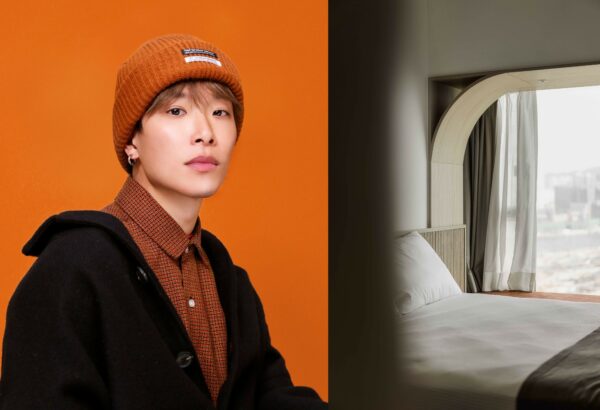
Tam Leo / Family Heirloom
How does this project reflect your personal philosophy and design language?
I believe that a home is the most comfortable and relaxing place for every individual. After a long day of work, returning home provides a sense of relaxation and rejuvenation.
The interior design of a residence should be tailored and planned according to each individual’s lifestyle and preferences. It is similar to a suit – while one can purchase off-the-rack suits from various stores, a custom-tailored suit that fits perfectly will provide a different and more suitable experience.
In this particular design, it has been created based on the homeowner’s envisioned retirement lifestyle. For instance, the homeowner expressed a desire to exercise while enjoying the beautiful view. Therefore, a multi-functional space has been incorporated within a glass room. It serves as a versatile area where she can work at a desk, sit by the window to read, and even accommodate fitness equipment. This allows her to engage in various activities while admiring the breathtaking view, creating a harmonious blend of leisure and exercise within the comfort of her home.
How do you integrate sustainability and environmental consciousness into your designs?
Paint Materials: The design incorporates the Italian paint brand VALPAINT, which meets the highest EU standards for safety certifications. It adheres to the environmental standards and certifications of various countries. I believe that paint is a crucial material in every space or residence, and it is essential to choose high-quality materials that are environmentally friendly and safe for health.
Natural Materials: Integrating natural materials such as wood and stone in interior design brings healthier effects to the indoor environment. These materials are renewable, durable, and have a lower environmental impact compared to synthetic alternatives. Opting for sustainable and long-lasting materials reduces the need for frequent replacements and minimizes waste generation.
Energy Efficiency: Sustainable interior design aims to reduce energy consumption by using energy-efficient lighting, appliances, and HVAC systems. Maximizing natural light through the use of windows, skylights, and light-colored walls also reduces the reliance on artificial lighting.
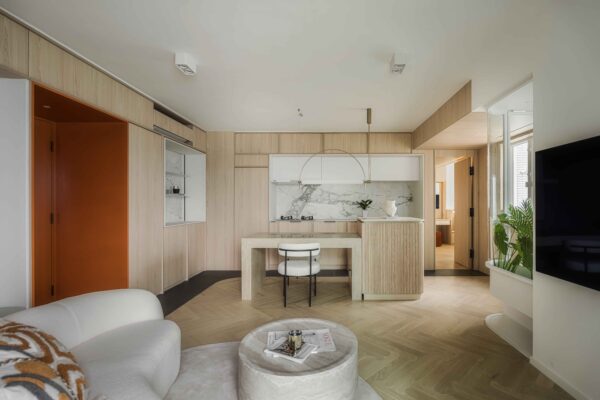
Can you share your creative process with us? How do you approach a new design?
I believe that every design should be unique, and it is crucial to avoid using cookie-cutter design approaches to prevent a sense of replication and pasting.
Each design should be tailored and planned according to the homeowner’s lifestyle needs and personal preferences. In my case, I have a habit of immersing myself in a design work mode during late nights, accompanied by groovy trumpet jazz music and some alcoholic beverages. I usually spend about a week working on the majority of the design and then make adjustments and modifications in collaboration with the homeowner to achieve a design that is deemed favorable by both parties.
This is how I combine my design ideas with the homeowner’s personal preferences to create one design masterpiece after another.
Congratulations on winning the BLT Awards! Are there any upcoming projects you’re working on at the moment that you can tell us about?
Thank you once again for the award presented by BLT. It is a great encouragement for me and motivates me to strive for even better designs in the future. I am truly grateful for the evaluation and appreciation from the jury members.
Recently, I have been working diligently on a recently completed design project. It is also a residential project for a single occupant, a 30-year-old engineer residing in a 600-square-foot home. This design emphasizes a sense of space and design aesthetics, while also seeking unique and artistic furniture pieces that reflect the homeowner’s individuality and appreciation for art.
What advice would you give to young designers looking to follow in your footsteps?
Through continuous refinement and improvement, each person’s unique style will gradually emerge and become apparent. It’s a process of honing your skills, learning from others, and developing your artistic voice. Embrace the journey of exploration and self-expression in interior design.
Studio MK27 located in the chaotic city of São Paulo was founded in the late 70’s by architect Marcio Kogan and today is comprised of 56 members and various collaborators worldwide. The team, coordinated by four directors, constitutes three main squads. Diana Radomysler, Marcio’s partner since the 90s, is the author of the interior design projects and coordinates its team.
We have talked to Diana about Studio Mk27’s project Flat #6 which won the Interior Design of the Year 2023 award at the BLT Built Design Awards.
Flat #6, designed by Marcio Kogan, Diana Radomysler, Luciana Antunes, and Mariana Ruzante, is a masterpiece that seamlessly blends Brazilian vintage design and woods. The interiors feature generous windows, lace curtains, and a thoughtful integration of living spaces, fostering a joyful family experience. The project’s attention to detail is evident in every aspect, from basaltine stone flooring to ipê wood panels.
Join us on a journey into the thoughtfulness and creativity behind Studio MK27’s Flat #6.
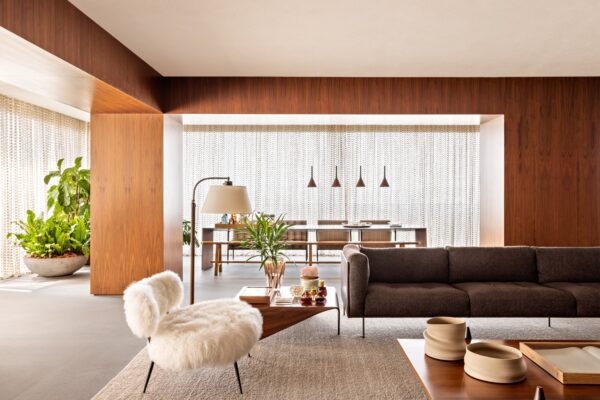
Photo Credit: Fran Parente and Christian Møller Andersen
Can you please tell us about your background? How did design come to have such an important role in your life?
Actually, I went for architecture without being much aware of what was architecture. I liked to draw, liked maths, and thought that the only school that could interest me was architecture.
Since I was little, I’ve enjoyed walking around the city with my parents. I am an only child, and my parents were foreigners; I am the first generation born in Brazil. They would go to downtown São Paulo and tell me a bit of the city’s history, take a look at buildings that looked like the ones from the cities they used to live in Europe… I had a connection with the city, with its buildings, they were how my parents told me their story.
What’s the core concept behind Flat #6’s design, and how did Brazilian vintage vibes influence the overall aesthetic?
Our project had the premise to create integrated settings and a strong relationship between spaces and the residents. Therefore, the covered terrace that embraces the living room, mediates the dialogue between the more intimate spaces and the unobstructed view of Sao Paulo’s skyline.
We also wanted to create a warm and solemn atmosphere throughout the apartment, where the fixed furniture – specially designed for the place – was in line with classical design objects, found in antique shops or already owned by the client. Brazilian modern furniture pieces bring the richness of different national woods and the elegance of forms.
The design of Flat #6 is a combination of textures with sharp forms. What’s the meaning behind this juxtaposition?
At the beginning of our work, Studio MK27 designed several white and aseptic projects. Gama Issa House is a good example of that moment.
In 2001, a new client asked for a house that couldn’t be white. At that moment, we started to experiment with the assembly of different natural materials. This experience ended up guiding our architecture after that.
The combination of modernist architecture with organic materials brought life to our designs. And that is important.
How does light influence the design and contribute to the ambiance of the residence, especially the golden light filtered with lace curtains?
As we are from Brazil, a tropical country where heat and light can be unwelcome in some periods and extremely suitable in others, being able to “move” light has always seemed fascinating. By doing so we work with the protective side of shadows while we bring a certain dynamism to our architecture.
Developed by the owner herself, the perforated artisanal fabric of the curtains acts like a soft mashrabya, filtering the sunlight and creating shadow drawings throughout the apartment.
Drawing with shadows, using light almost as a touchable material, is part of an attempt to create an atmosphere, to highlight the tactile dimension of spaces.
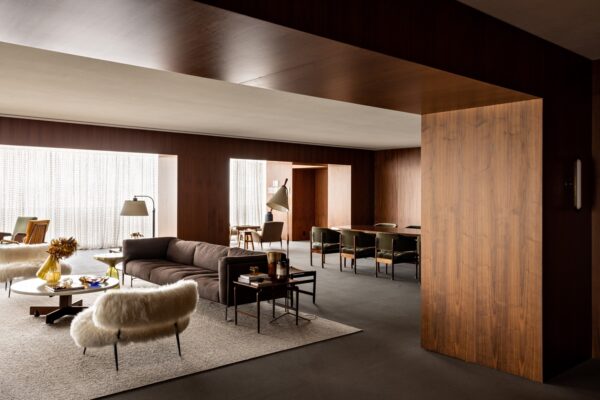
Photo Credit: Fran Parente and Christian Møller Andersen
Were there any challenges you faced while designing Flat #6? How did you overcome them?
The original apartment project (delivered by the developer) was very compartmentalized and ”lost” a lot of space with residual internal circulation spaces/passageways, therefore, the main challenge was to rearrange the original plan in order to create larger spaces.
Studio Mk27 has been in the architecture field since the 70s. How has your design philosophy evolved over the years and what aspirations do you have for the studio in the coming years?
We like the idea of trying to improve and change with simplicity, gentleness, and elegance. That’s is our motto: top evolve with simplicity, and collaborative work, allowing young architects to have an active voice and a creative role; trying to invest in new research at the studio: wood structure, sustainability, etc.
Flat #6 won the “Interior Design of the Year” prize at the BLT Built Design Awards, congratulations! How does winning this award impact Studio Mk27 and its future projects?
I guess Flat #6 project exemplifies a number of mk27’s main premises: the value of detailing, the constant search for enlargement of spaces and the choice of natural and tactile materials, that bring architecture closer to our bodies. Therefore, it’s an honor to be recognized by BLT Built Design Awards with this project, it means we are on the right path.
What advice would you give to young designers aiming to make a mark in the world of interior design?
Good design is timeless. Technology will be more present, during conception and construction, but the result should aim to be timeless.
The BLT Built Design Awards, a prestigious celebration of innovation and excellence in architecture and design, took center stage at the iconic KKL Luzern, Switzerland, last Saturday, November 18th. The gala event, set against the stunning backdrop of KKL Luzern’s architectural brilliance, showcased the industry’s top talents and their remarkable contributions.
The evening commenced with an inspiring opening speech by Dominic Sturm, the President of the Swiss Design Association (SDA), setting the tone for an evening of recognition and celebration. The event featured an illustrious list of attendees, showcasing the diversity and excellence within the global design community. Among the prominent figures in attendance were: Rubén Navarro – Casas Inhaus, Oliver Schütte – A-01 (A Company / A Foundation), Mohammad Rahimizadeh – Kalbod Design Studio, John Lloyd – Studson, Yvonne Dollega – Gronych + Dollega Architekten, Mathias Haas – Kaufmann Haas & Partner Zt Kg, Marcel Eberharter – EBERHARTER Innenarchitektur & Gesamteinrichtung, Ingrid Rodrigues – |.iR 15 | arquitetura, Raulino Silva – Raulino Silva Arquitecto, Anna Chincoli – ALTER EGO Project Group and many more.
Awarded with the “Design of the Year”, the winners recipients included:
The awards were presented by an esteemed jury panel, including Stanislas Helou, the founder of Thinking Luxury, Colleen Cocotos, Senior Lecturer at Cape Peninsula University of Technology, and Anna Grichting Solder, an architect, urbanist, and musician at Bordermeetings Switzerland and graduated with a Doctor of Design in Urbanism from Harvard University.
Reflecting on the gala, Hossein Farmani, co-founder of 3C Awards, expressed, “The BLT Built Design Awards Gala was an extraordinary display of design brilliance, showcasing the dynamic nature of the industry. Witnessing these visionary designers redefine our spaces was truly inspiring. We’re privileged to be part of a celebration that pushes the boundaries of creative excellence.”
Astrid Hebert, co-founder of 3C Awards, added, “The atmosphere at the BLT Built Design Awards Gala was truly electric. Gathering the best minds in the industry under one roof was a standout moment. The entire event pulsated with the dynamic energy of the design world’s absolute best.”
Following the awards ceremonies, attendees were treated to a sumptuous cocktail dinner reception—a perfect opportunity for professionals to connect, share insights, and revel in the shared passion for innovation and creative expression. The atmosphere was truly festive, ensuring everyone had a delightful time and adding to the overall experience of the evening.
As the night concluded, the excitement lingered, and the BLT Awards are already gearing up for another spectacular event. Stay tuned for updates on submission dates for 2024 at bltawards.com to be a part of the next chapter in celebrating outstanding design achievements.
With an illustrious career spanning over five decades, Mr. Thomas P. Murphy, Jr. has not only shaped the skyline of Florida but has been at the forefront of transformative projects that have redefined the very essence of construction. As the Co-Founder of RENCO, he brings a wealth of experience and expertise to the table. Notable projects, including the Ocean Reef Club, The Surf Club/Four Seasons, and the Ritz Carlton SoBe, stand testament to his commitment to excellence.
This year, RENCO’s groundbreaking work in construction design has been recognized with the prestigious Construction Product Design of the Year. In this exclusive interview, we delve into Mr. Murphy’s remarkable journey, exploring the milestones that have shaped his career and the innovative ethos that propels RENCO to the forefront of the industry.
Welcome to an exclusive interview with Takatoku Nishi, a student at Tokyo University of the Arts, whose creative journey is deeply rooted in his fascination with the transitory yet intense beauty of the ever-changing scenes of nature. His unique approach involves capturing the atmospheric optical phenomena found in these fleeting moments and masterfully reconstructing them through the interplay of ‘materials’ and ‘structures.’
Can you tell us about your background? How did design come to have such an important role in your life?
I developed a strong obsession with buildings due to the influence of having moved more than ten times since childhood, and at the age of nine, he dreamt of becoming an architect. I was a crafty child who liked to make my own playthings and play in familiar natural surroundings such as forests, rice fields, and rivers. I only wanted to do what interested me, and I often rarely went to school. I would lie down on a nearby shrine’s ball fence (Tamagaki) to wait for my friends to return from school. It was then that I felt the sound of the wind blowing, the temperature, the changing sky, sunlight filtering through trees (Komorebi), the smells of the seasons, and the coldness of the stones. These sensations and experiences later became part of my design.
What’s the inspiration behind Ripple? How did you get the idea to use light and wind to create the natural phenomenon of water drops?
The inspiration for this work came from discoveries made through experiments with light. I discovered that passing light through a pipe creates an interesting optical phenomenon. The phenomenon looked exactly like a drop of water. I then started to think about whether I could realize this phenomenon with the movement of sunlight and wind. The method of completing a work by natural forces has always been a main idea for my work. This inevitably led me to this form. This time, I aimed to create a special space created by a combination of certain conditions, like a rainbow created by a natural phenomenon.
Your work is a seamless mixture of art, nature, and humanity. Can you tell us about your personal philosophy when it comes to architecture and design?
I believe that the most beautiful spaces in this world are the fleeting scenes created by nature. For example, the view at sunset always seems beautiful. I believe that humans are no match for such a scene. I just aim to create new spatial expressions that can be created by borrowing from this power. This method is deeply connected to architecture.
What were the major challenges you faced during the design and construction of Ripple? What did you learn from this project?
First of all, in the design phase, the optical phenomena discovered in the experiments were model size and the light source was LED. It took a lot of work to find a way to make this work in a real space size and using natural forces. It was particularly difficult to find a way to direct the sun’s rays into the pipes. Also, as the budget was limited and the construction was basically intended to be carried out by one person, the design of the space was divided into sections that could be carried by one person, and care was taken to avoid wastage of materials. During the construction phase, there was some fatigue due to the physical labour involved, but compared to the design phase there were no major problems. Through this project, I became more aware of the wind speed and sun angle of the environment.
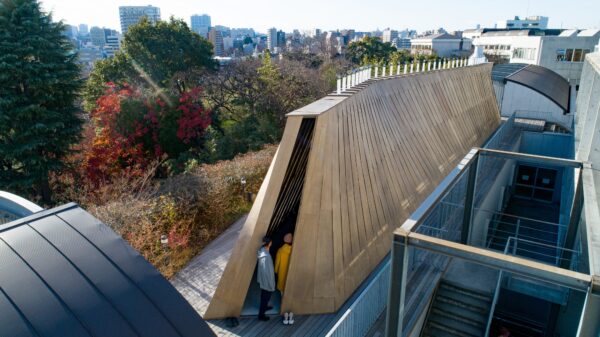
Photo Credit © Nacása & Partners Inc. Futa MORIISHI, DRONE SHOOTING : Yukihide Nakano
Can you explain the design process behind the pipes in the ceiling? How did you determine their size, placement, and spacing to achieve the desired light phenomena?
I calculated the ratio between the LED light in the experiment and the actual sunlight, started to verify how many times the pipe could be realized, and from there, it was just a matter of experimentation. First, I experimented with several different pipe sizes in terms of length and fineness. The ceiling height of this work was 4 m, so I selected the one that showed the most phenomena when the pipes were installed from this height. The material of the pipes was also tested together at this time. The size and material that best suited the diameter and the effect on the light in the pipe was the size and material used this time. Once the pipe is selected, it is a simple matter to record several patterns of the diameter of the light phenomenon, average them, place them on the drawing, and verify them. The most pleasing overlap is then determined. In this case, the light falling into the space was intended to flow, so it is not in a straight line, but in motion. At the design stage, there was another pipe close to the entrance, but when I looked at it while actually building it, I felt that the pipe was too noisy, so I removed it in a hurry.
Ripple is located between Tokyo’s Zoo and the Tokyo University of the Arts. How did the surrounding environment influence construction and design decisions, especially considering vegetation and animal presence?
In terms of the natural environment, I tried to incorporate the forces of nature by taking data on the sun angles and wind speeds and averaging them. Also, as environmental sounds, the sounds of animals and moving plants can be heard pleasantly in this place. Therefore, I thought that the artwork could also take in a lot of outside air.
Why did you decide to undertake all the construction yourself? Did this approach give you any unique insights or advantages?
To be honest, the reason I did the whole process myself was partly due to budgetary considerations. But also because I am not able to create a space just by designing it. So I touch the materials with my own hands and complete the work in a style that is in tune with the situation. Therefore, I do all the processes myself, which allows me to better understand the characteristics of the work. It also allows me to get to know the quality of the materials and leads to new ideas.
Looking back, is there anything you would have done differently? Do you think you would re-use this idea in a future project?
The area that I wanted to prepare more is the floor finish. The floor was plastered over the composite because it had to be hypothetical. The original floor level was not good enough, which caused the plaster to crack. That is a frustrating part. The idea for this piece is to reuse it when the opportunity arises. However, I decided on the shape and atmosphere of this piece to suit this location, so the next one I make will have a completely different look.
Congratulations on winning the Emerging Architect of the Year prize at the BLT Built Design Awards! How do you feel being recognized for your work and how do you see this prize influencing your future?
First of all, I am very honoured to have been chosen for this award. I was very happy. As for the impact on my future, I honestly don’t know. I hope it will have a very big impact. I am looking forward to seeing how it will turn out.
Where would you like to see yourself in a decade?
It was exactly ten years ago that I won my first award for a spatial work on the theme of light. Ten years from now, I would like to devote myself to winning another major award. For that to happen, I hope that I will be able to exceed my current level of enthusiasm.
In the heart of Vals, Switzerland, Truffer AG, a pioneer in the stone industry since 1983, celebrates their recent accolade—the Architectural Design of the Year Award for Haus Balma. Employing over fifty individuals year-round, the Truffer legacy, founded by Pia and Pius Truffer, integrates tradition with visionary design.
Situated near Zervreila, their quarry, “Jossagada,” produces Vals quartzite, transformed into an array of end products. The family’s philosophy, rooted in a passion for architecture and design, has led to steady growth and global recognition as leaders in the natural stone industry. This commitment to innovation is exemplified in their latest building, a collaborative venture with renowned architecture firm Kengo Kuma & Associates.
In an exclusive interview, we explore the story behind Haus Balma’s triumph, the challenges faced, and the profound impact of their architectural passion on the global stage.
Can you tell us a bit about your company background? How did Truffer AG envision a building that harmoniously marries modernity and tradition?
Our company philosophy is characterized by a keen interest in architecture and design, a commitment to developing new processes and products, and a general openness to new and unknown possibilities. This mindset may have unconsciously led us to the right architect for our new business and residential building. In Kengo Kuma, we have found a master who allows materials to speak. He utilizes our stone in Haus Balma in an entirely innovative manner. Nevertheless, the building harmoniously blends with its surroundings, despite its distinctive shape and unique facade.
What was the inspiration and initial vision for Haus Balma? How did it evolve during your collaboration with Kengo Kuma & Associates?
Since the construction of the Thermal Spa by Peter Zumthor in 1996, the mountain village of Vals has become synonymous with excellent architecture. In addition to the Felsen Therme, other architecturally outstanding buildings have emerged, such as the ‘Dorfbrücke’ by engineers Conzett, Bronzini & Gartmann or the Hotel Alpina by architect Gion A. Caminada. With our construction, we aimed to continue this legacy. We wanted a house that showcases the stone in its most beautiful form.
Why choose Kengo Kuma & Associates as the main architect? Are there any memorable moments or insights you want to share?
The choice of the architect happened rather coincidentally: Pia and Sokrates Truffer visited a stone fair in Beijing, China, in 2011 and stayed at the Opposite House, a hotel designed by Kengo Kuma. Both were enthralled by the architecture and fascinated by the use of natural materials. Shortly after their return from Beijing, we reached out to Kengo Kuma and fortunately, we received positive news from Japan.
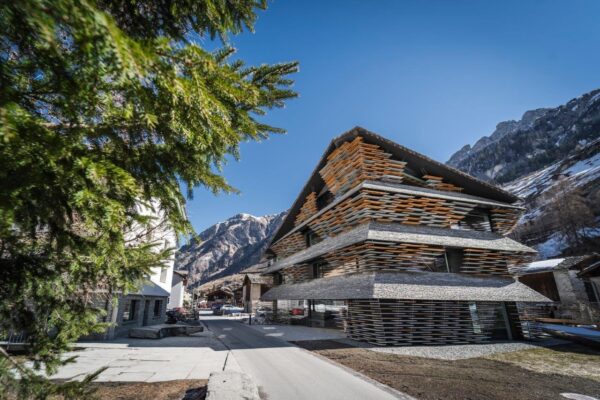
Haus Balma’s design is all about harmony with nature. Was this a central detail for you? Do you feel like the final design has exceeded your expectations?
As the client, we wanted to grant the architect as much freedom as possible. We knew that Kengo Kuma & Associates would take the nature and the surroundings of Vals into account. One of KKAA’s principles is to create harmony between architecture, nature, and the surroundings. That’s why, at the beginning of a project, KKAA thoroughly engages with the local conditions and the unique history and traditions of a place. To arrive at architectural design and form, they looked for an element that connects all of these aspects, and then strive to balance them correctly.
Stone is a pivotal connector between wood, metal, and glass. What is the significance behind this choice of materials, especially stone?
As previously mentioned, we provided minimal specifications. However, there was one essential requirement for us: Vals Stone had to have a prominent place in our new headquarters. The architect was granted creative freedom to determine how to integrate it. We are captivated and absolutely delighted with how our stone has been integrated into the building. Our expectations have been exceeded.
Which challenges did your company face during the construction phase, especially given some of the unique design elements of the project such as the floating stones?
The construction of the building presented significant challenges to the executing companies. As the stone producer, we were also challenged with translating KKAA’s drawings and renderings into reality. The delicate curtain wall façade, comprising approximately 900 stone panels and 500 wood panels, posed substantial challenges, and multiple mock-ups were required before achieving the concept of ‘floating stones.’ The initial samples were not very promising: the holders and fasteners for attaching the panels were too bulky, and the steel cables were too thick. Efforts to achieve a sense of lightness and translucency were in vain. However, working together, we successfully addressed the structural challenges, employed the attachment elements as discreetly as possible, and achieved the effect of the stones appearing to float.
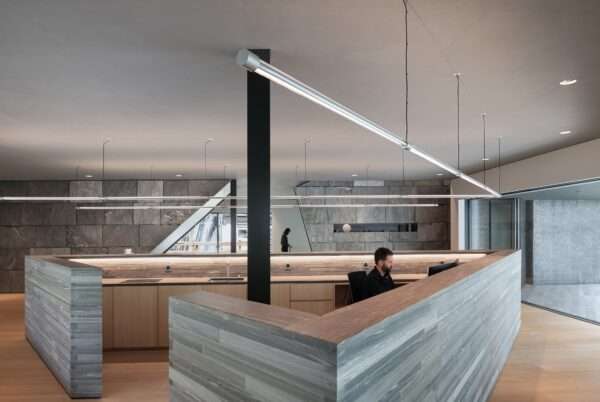
How was the collaborative process with Kengo Kuma & Associates? Are there any memorable moments or insights you gained?
Our collaboration with Kengo Kuma & Associates extended over a 10-year period, primarily due to the lengthy planning and construction phases. Throughout this entire duration, the collaboration was exceptionally pleasant. We can imagine that KKAA greatly appreciated the ‘artistic freedom’ granted to them in this project. In return, we made every effort to accommodate their design preferences whenever feasible (provided that the building material, natural stone, allowed for it). We genuinely valued and admired KKAA’s unwavering commitment from the project’s inception to its completion. Kuma’s office scrutinized nearly every design detail. A meeting with Yuki Ikeguchi and the local project engineer is unforgettable to us, as there was an intense debate about the number and dimensions of supports required in construction. Ms. Ikeguchi’s persistence and perseverance continue to stand out in our memory.
Notably, Spreiter AG played a crucial role in the success of this project. Serving as the execution planner and on-site manager, they often acted as the link between the client and the architect.
Can you please share with us what winning the Architectural Design of the Year at the BLT Built Design Awards 2023 prize means to you? What’s next for Truffer AG?
We feel truly honored to have received this award, and we will proudly display the trophy at Haus Balma. Our house is meant to be a place of encounters, a house that is open to all. It’s a place where customers, tourists, culture enthusiasts, residents, and many more come together under one roof.
Welcome to the exclusive interview with the esteemed Catherine Mosbach, a visionary landscape architect and the founder of the Paris-based design firm mosbach paysagistes & the magazine Pages Paysages. With a remarkable career spanning diverse and innovative projects, Catherine has left an indelible mark on the world of landscape architecture.
Catherine’s key projects include the Solutre Archaeological Park in Saone-et-Loire, Walk Sluice of Saint-Denis, the Botanical Garden of Bordeaux, the other side in Quebec City, Shan Shui in Xian & Lost in Transition in Ulsan. She was the recipient of the Equerre D’argent award with Kazuyo Sejima & Ryue Nishizawa for the Louvre Lens Museum Park & was honoured in the Iconic Concept Award category by the German Design Council and Platine Award by INT.design 15th Montreal for Phase Shifts Park in Taichung. The team is honoured Firm of the Year 2021 in Landscape and Urban Design by Architecture Master Prize Los Angeles. Catherine was named a knight of the Legion of Honour proposed by the President of the Republic Francois Hollande in 2016. In the net of desires with ovvo studio explores the infinitesimal of the living by XXI Triennale de Milano 2017. Some of her latest essays are ‘emersion’, dialog Jerome Boutterin with Catherine Mosbach. Jerome Boutterin Reboot 1999-2022. (eds.) snoeck MMBOOKS BELGIQUE and ‘de passage’ la couleur en questions, directe by Michel Menu, Jean-Marie Schaeffer, RomainThomas; Collection la Nature de l’oeuvre, ed Hermann. 2023.
Most recently, mosbach paysagistes received the prestigious Landscape Architecture of the Year award, further affirming their influence and excellence in shaping the world’s landscapes.
We recently had the privilege of delving into Catherine’s creative process, her thoughts on the evolving landscape architecture industry, and her insights into the future of urban and natural environments. Join us as we explore the world of landscape architecture through the lens of a true innovator and pioneer, Catherine Mosbach.

Can you tell us a bit about your background? How did design come to have such an important role in your life?
I grew up in the countryside. I wanted to work in contact with nature. I didn’t have the level required to enter the Ecole d’Ingénieur des Eaux et Forêts. I decided to study the Physics and Chemistry section of the Natural Life Sciences at the University of Louis Pasteur in Strasbourg. In the guidance centers, There I discovered the Ecole Nationale Supérieure du Paysage de Versailles. The drawing took a while to mature because it wasn’t my favorite field. The biology-physics-chemistry dimension is anchored in my vision of the landscape project, a rare practice involving the exploration of living things from the perspective of a vision in real-time.
What was the inspiration or philosophy behind the design of Phase Shifts Park?
It is essential to reconcile the disciplinary polarities that at every attempt is made to set against each other in public debates. Man is as natural as a tree. Ecology is as much a cultural discipline as philosophy. This 250-hectare new urban development provides a meeting place for landscapes, and cultural events with animal, plant, and human populations, with respect for different ‘natures’. Given the humid tropical climate, people are not used to spending time outdoors. The monsoon season is, therefore, an opportunity for ‘landscapes in action’, seen as a drama-free ‘performance of the elements’.
The park was designed to be a living and breathing creature. Can you elaborate more on this concept and how it was accomplished in the design?
Two singular sensibilities and two singular itineraries, those of Philippe Rahm and myself have pooled their skills for the benefit of a public space. This should be a common ground by definition, but it’s far too rare in the professional practices of architecture, landscape, and engineering, where projects are too often lumped together without any real alliances in terms of substance. Design, on the one hand, plays with available resources, and the energies of the living, on the other, relay continuous regeneration.
You managed to uniquely combine lithosphere and atmospheric elements. What was the thought process behind this and what is its significance?
The challenge is to retain all the rainwater on a site with a slope of more than 2,7km, with the aim of replenishing the water table, which has been depleted in recent years due to shortages of drinking water. The balance of cut and fill required means that the roads can be crossed to ensure continuity of ownership, fauna-flora-inhabitants from north to south. This topographical work, macro, and micro, nourishes the soil at the same time as it cultivates water, in the sense that the volume of water rising from the ground to the sky is just as important as the volume descending from the clouds to the ground, in different forms. Fertile soil is home to a vast array of plant species, the key to ‘cultivating water’. In addition to the topography, the typologies and installations are fine-tuned according to the winds, the polluted particles from the roads, and the shadows cast by the future building fronts, so as to provide freshness and healthy air, away from the dampness of water in transit. Lithosphere and Atmosphere are inseparably linked for the common good.
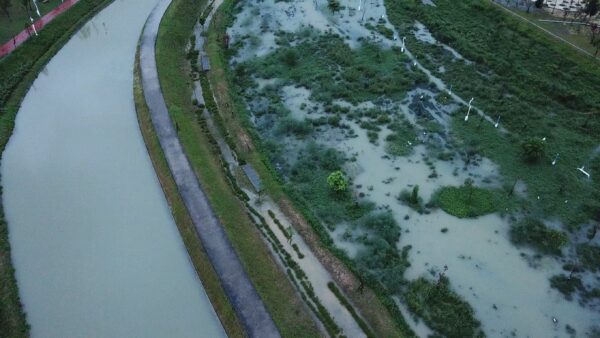
What were the major challenges faced during the design and construction of Phase Shifts Park? What did you learn from designing the park?
Setting parameters down to the square centimeter on more than 67 hectares in order to achieve the expected performance is a challenge in the landscape field. This is where drawing is an invaluable tool, which the fashion of the moment tends to relegate to the background, on the pretext of ecological issues. The experience gained from past projects is not easy to pass on in a country where companies have few references in this field. The trusting relationship with the municipality helps to overcome certain obstacles, such as discovering that the teams did not understand the plans. An ambitious project owner who is courageous in the face of incomprehension and public doubt, who is wary of what he does not know, is just as essential as an enlightened project manager. One cannot exist without the other, which is the cornerstone of a long-term operation. It is in this respect that we need to nurture our clients’ appetite for ambitious projects. Awards help in this respect.
How does technology, like the Computational Fluid Dynamics simulations and the sensor mesh, contribute to the park’s sustainability and efficiency?
Technology is one of the pillars of understanding a site and the data to be mobilized for efficient performance. However, an instrument is no substitute for the mind and sensitivity. In this case, it’s a question of mobilizing all the tools simultaneously, not in a linear and deductive mode, but in an iterative mode. This is why excessive use of data is not a solution when it supplants the interpretation of competent players. Access to the data collected, and transcribed onto computers in the maintenance center, is a tool for understanding and anticipating fleet management, provided that the right staff are on hand.
What kind of interactions between visitors and the park’s features did you want to achieve when designing Phase Shifts Park?
The diversity of lands and situations according to the time of day, the seasons, and the growth of the trees is a source of inspiration for young and old alike. The places under bridges and tunnels’ crossing traffic lines offer instant freshness and a resonance chamber for the sound emitted, on par with that of a cathedral. These are ad hoc territories for all kinds of inspirations and artistic performances.
Congratulations on winning the Landscape Architecture of the Year prize! How does it feel to be recognized for your hard work?
The efforts and obstacles are considerable, but they are not superfluous in convincing elected representatives and professionals to be ambitious and to combine their efforts so that landscape, architecture, and the city evolve in good alliance. It is a universal challenge to learn to live well together and to dream together – the only way forward for humanity in the future.
Which advice would you give to aspiring landscape architects who want to make a significant impact in the field?
Cultivate an appetite for working in inter-skill synergy – architect, artist, botanist, ecologist, biologist… – to increase the potential of your work. Take care of your intuitions and your dreams and they will come true. Landscape architects have the interdisciplinary skills to offer this gift to the worlds of tomorrow.
A student at Savannah College of Art and Design, Gabriel Velasco, has been awarded the Emerging Landscape Architect of the Year at the 2023 BLT Built Design Awards for his work on Octavarium. In this interview, we’ll delve into Gabriel’s journey, tracing it from his roots in Brazil to his current studies in the United States. We also discuss Octavarium, from its sustainable design principles to the emotions it seeks to invoke in those who experience it. Gabriel’s vision is one of reflection, where visitors are guided to contemplate the fleeting nature of life.
This conversation will take you on a journey through Gabriel’s creative mind, as he redefines both landscapes and the way we view life. Join us in this interview and catch a glimpse of the bright future ahead for this rising star in landscape architecture.
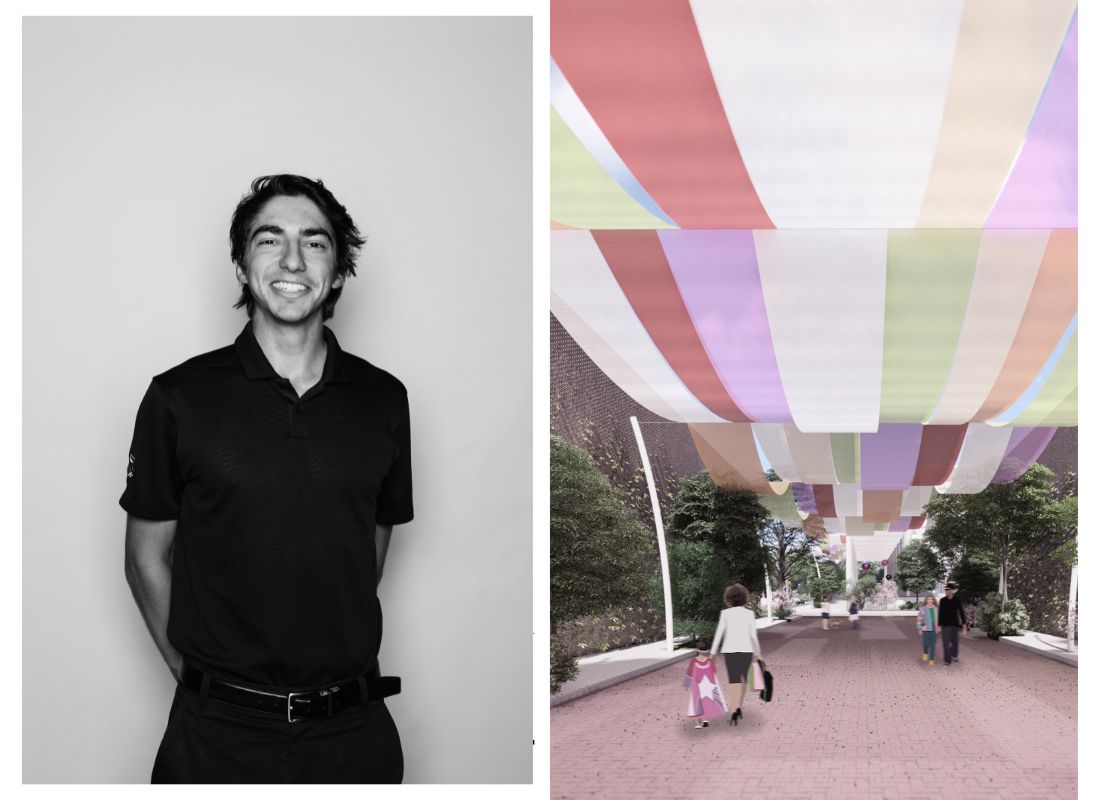
Can you tell us a bit about your background and studies? How did design come to have such an important role in your life?
I grew up in Brazil, with a family-driven childhood, learning how to be honest and dedicated. Moving to Savannah, in the U.S., I started my career at Savannah College of Art and Design (SCAD), where I conquered a B.F.A. in Architecture and where I am currently pursuing an M.Arch. As an artist/athlete, the blend of two dreams became a reality, and I represent both, from classrooms to championships. Design became a lifestyle when I noticed that it is much more than completing assignments or projects, is the search for answers in your personal life. I believe that designing in the architecture field incorporates empathy in different degrees, for people, for senses and for time.
What was the inspiration or philosophy behind Octavarium? How did you choose the name?
Octavarium is a project that blends the lines of the built environment. The woonerf proposal is a study of an urban strategy for the neighborhood, the garden as a conceptual landscape exploration, the entrance renovation as the architectural language of the project, and the spheres exhibition as the step toward interior installation. The project intention started after analyzing the urban fabric of the city of Savannah, studying the layout of the squares since 1733, when the city was founded. The main cemetery, located downtown, was the first square out of the proposed layout, with the objective of celebrating death. With that, the Jonny Mercer Theater is located between the same streets, being also out of the layout, giving the contrast of celebrating life.
Octavarium focuses on the influence of time on our life experiences, which is shown using spheres as the life cycle and swings as time itself. Can you tell us more about this vision and explain the details of how you incorporated it into your design?
Since the intention is to celebrate life, to contrast against the cemetery, I started to reflect about elements that drives human existence, asking myself questions about the purpose of living. Understanding that humans are aware of death, our journey ends where it begins, we are born at some moment in time, and we experience death at some moment in time. That process is something out of our control, we can only choose our paths during our existence, arching around a sphere, until we reach the starting point, and ending where we began. The swings element represents how humans are supposed to perceive time, where to get in and out the swing must be static in the present, than swinging back and forth between future and past.
How did you incorporate sustainable design principles into Octavarium?
The project adapts sustainable communities, green plazas, and human well-being. The woonerf proposal transforms McDonough St. into a gathering plaza, with commercial and residential developments. Octavarium also serves as a connection point between downtown Savannah and the plans for west expansion of the city. The use of Elbert Square also maximizes the use of the size, proposing a renovation of the square to its original size.
What do you hope visitors will feel or experience when they interact with your creation?
Octavarium was designed to be a moment of reflection, where people would interact with each part of the project, receiving guidance and awareness about decision-making towards being present somewhere in time. Life is short, a warm moment, death is a long cold rest, we get your chance to try in a twinkling of an eye. Families, friends, and individuals will experience in peculiar ways, some spheres are bigger than others, some spheres are buried, and some spheres are over water, each sphere represents different moments in life, dictated by time.
What were the major challenges faced during the design process and what did you learn from the whole project?
When the project was introduced to me, the main challenge was to combine urban design with architectural purposes, then stretching even more towards landscaping and interior installations. I also found myself reflecting on my moment in time, my priorities, and my reasons to live. The mental challenge of this project was to organize the story I wanted to portray with an architectural language that would adapt humans to the site’s program. With that, the main lesson that I took from Octavarium is about understanding why we do things that we do, and how can we make decisions that would interfere with our future. This project also gave me an opportunity to think rationally, considering life through facts and transforming them into emotions.
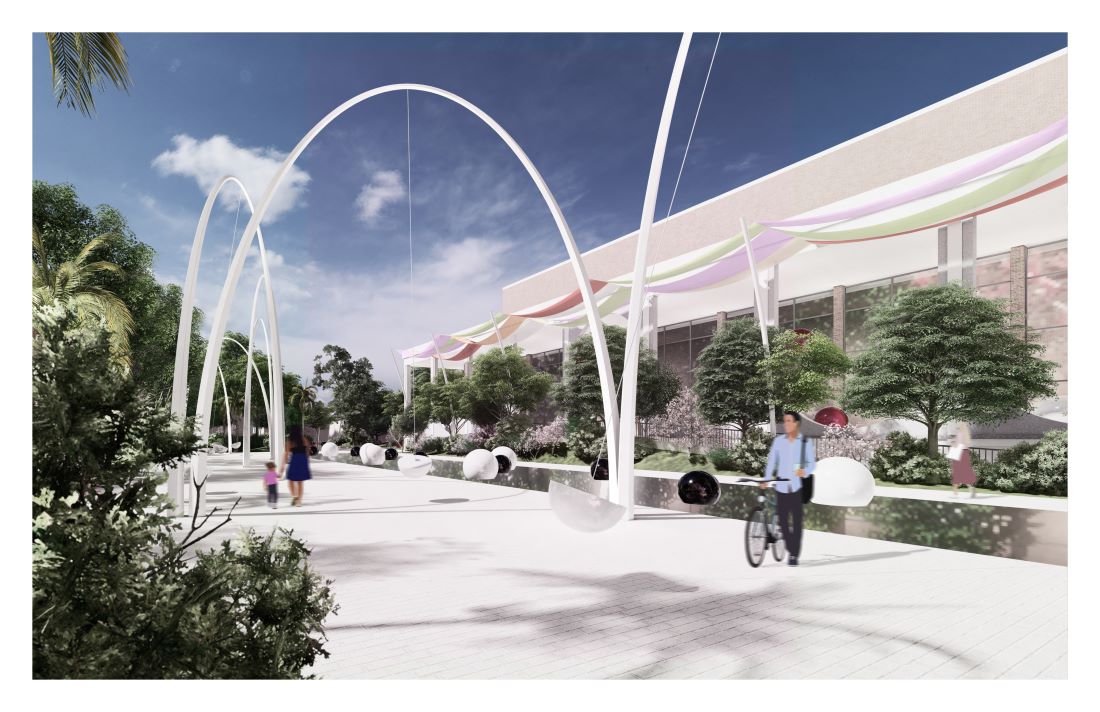
Congratulations on winning the Emerging Landscape Architect of the Year prize! How does it feel to be recognized for your hard work?
It is an honor to be part of the Built Design Awards! Receiving the Emerging Landscape Architect of the Year is amazing, it is always wonderful to see hard work paying off. I learned architecture through emotions, being taught to incorporate feelings and empathy into my projects, and Octavarium has its own personality. I also feel honored for the appreciation of my work related to what the project means, to understand what is the design’s purpose.
After the success of Octavarium, what are your plans for the future? Where would you like to see yourself in a decade?
Swinging in the future, I see myself exploring the world, spreading ideas to evolve into moments fulfilled with emotions. Time passes equally in the physical world, architectural concepts and stories are immune to aging, I believe I will be studying, reflecting, and experiencing the built environment during my period in time. As I grew in this field, architecture shaped who I am, my goal is to design the moment for someone else to find their place in time.